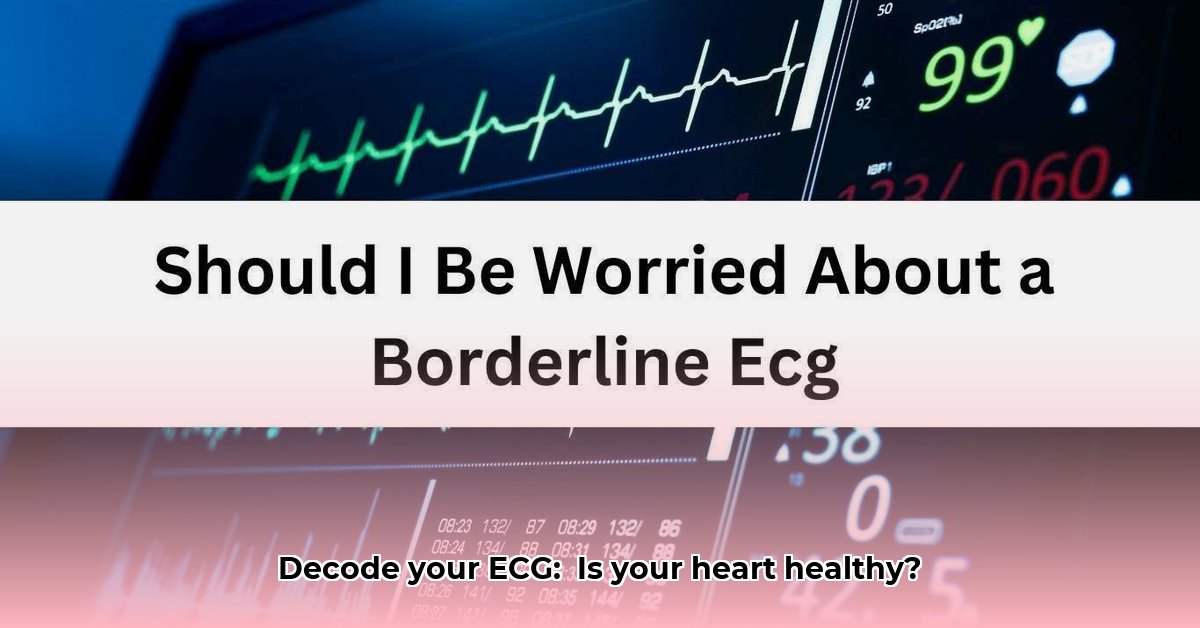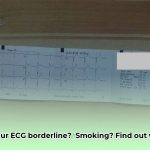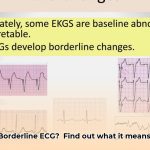Got a borderline ECG result and feeling a little confused? It’s understandable – that fuzzy “in-between” result can be worrying. This article will help you understand what a borderline ECG means, why it might happen, and what you and your doctor should do next. We’ll break down the possible causes, explain how doctors interpret these results, and walk you through the steps to take for better heart health. From lifestyle changes to follow-up tests, we’ll cover it all in simple terms, so you feel confident in taking charge of your heart health. Let’s clear up the mystery and get you the answers you need for a healthier heart. For more information on next steps, see this helpful guide: Next Steps.
Borderline ECG Criteria: Navigating Uncertain Heart Signals
A borderline ECG (electrocardiogram) result isn’t a heart attack diagnosis; it’s more like a “check engine” light on your car dashboard. It suggests something’s slightly off in your heart’s electrical activity, but it’s too vague to pinpoint an exact problem. A normal ECG shows a clear, consistent pattern reflecting healthy heart activity. A borderline result means the trace shows some small irregularities—things slightly off the usual pattern. It’s not a clear-cut problem, but it’s also not perfectly normal, prompting the need for further investigation to rule out any underlying issues.
What is a Borderline ECG?
Your heart beats because of electrical signals. An ECG measures these signals, creating a waveform tracing that doctors analyze. A borderline result means the trace shows some small irregularities—things slightly off the usual pattern. It’s not a clear-cut problem, but it’s also not perfectly normal, prompting the need for further investigation to determine the cause and ensure that serious conditions are ruled out.
Why Do Borderline ECG Results Happen?
Many factors can cause a borderline ECG reading. It’s like a puzzle with many possible pieces fitting together. Some common possibilities include:
- Temporary Factors: Stress, anxiety, caffeine intake, dehydration, intense exercise, or changes in electrolyte levels (like potassium, magnesium, or calcium) can affect heart rhythms leading to minor variations. Even the way you’re breathing during the test can influence your ECG reading. These are often temporary and resolve without treatment.
- Medications: Certain medications, including some antidepressants, antihistamines, and decongestants, can influence your heart rhythm and show up on an ECG. Beta-blockers and digoxin, commonly used to treat heart conditions, can also affect ECG results.
- Underlying Conditions: In some cases, a borderline ECG might suggest an underlying heart condition that requires further evaluation. Conditions like high blood pressure, mild coronary artery disease, or even early stages of cardiomyopathy may manifest as borderline changes on an ECG. Other conditions such as thyroid disorders, sleep apnea, and anemia can also indirectly impact heart function and ECG readings.
- Technical Issues: Sometimes, the borderline ECG can be attributed to external factors during the test itself. Incorrect electrode placement, poor skin contact with the electrodes, or even electrical interference from nearby devices can sometimes lead to a borderline ECG result.
Decoding Your ECG Report: What Doctors Look For
Your doctor examines various aspects of your ECG tracing. They carefully look for:
- Heart Rate: A normal resting heart rate typically falls between 60 and 100 beats per minute. A borderline ECG might show slight deviations, with a heart rate slightly above or below this range.
- Rhythm: Is your heart’s rhythm regular, or are there irregularities (arrhythmias)? The heart should beat with a consistent rhythm. Slight variations aren’t always cause for concern, but they need further investigation.
- Intervals: Healthcare providers also carefully analyze the intervals between the different waves on the ECG. The PR interval, QRS duration, and QT interval are all carefully scrutinized. Prolonged or shortened intervals can sometime indicate conduction abnormalities or electrolyte imbalances.
- Waveform Shape: Does the shape of the waves on the tracing look normal? Doctors will examine the P waves, QRS complexes, and T waves. The peaks and valleys in the waves contain important information about your heart’s function. Small variations deserve a closer look.
- ST Segment: The ST segment represents the period when the ventricles are contracting but not repolarizing. Deviations such as ST elevation or depression can indicate myocardial ischemia or other heart issues.
What You Should Do After a Borderline ECG Result
Getting a borderline ECG result is understandably worrying. It’s crucial to approach this situation calmly and take proactive steps.
Step 1: Talk to Your Doctor: This is the most critical step. Schedule a follow-up appointment to discuss the results. Don’t hesitate to ask questions; clear communication is key. Before the appointment, write down any symptoms you’ve been experiencing, medications you’re taking, and any relevant medical history.
Step 2: Consider Lifestyle Changes: Even if the borderline ECG isn’t linked to a specific issue, adopting a heart-healthy lifestyle can improve your overall well-being. Focus on these key areas:
- Diet: Eat a balanced diet rich in fruits, vegetables, and whole grains, and low in saturated and trans fats. Reduce your intake of processed foods, sugary drinks, and excessive sodium.
- Exercise: Aim for at least 150 minutes of moderate-intensity or 75 minutes of vigorous-intensity aerobic exercise per week, along with strength training exercises at least two days a week.
- Stress Management: Incorporate stress-reducing techniques into your routine, such as yoga, meditation, deep breathing exercises, or spending time in nature. Limit exposure to stressors when possible and prioritize activities that promote relaxation and well-being.
- Quit Smoking: If you smoke, quitting is one of the best things you can do for your heart health. Seek support from healthcare professionals, support groups, or smoking cessation programs to increase your chances of success.
- Limit Alcohol Consumption: If you drink alcohol, do so in moderation.
- Maintain a Healthy Weight: If you are overweight or obese, losing even a small amount of weight can significantly improve your heart health.
Step 3: Undergo Further Testing (If Recommended): Your doctor might recommend additional tests to get a clearer picture. Common options include:
- Repeat ECG: A simple repeat ECG can help determine if the initial finding was a fluke or a consistent pattern.
- Holter Monitor: This is a portable ECG device that records your heart’s activity continuously for 24-48 hours. This can help detect intermittent arrhythmias or other abnormalities that may not be apparent on a standard ECG.
- Event Recorder: Similar to a Holter monitor, an event recorder is worn for a longer period, typically 30 days. It records heart activity only when you experience symptoms, allowing for correlation between symptoms and ECG findings.
- Echocardiogram (heart ultrasound): This provides detailed images of your heart’s structure and function.
- Stress Test: This test evaluates how your heart responds to physical exertion. It can help identify coronary artery disease or other conditions that may not be apparent at rest.
- Cardiac CT scan: This advanced imaging technique provides cross-sectional images of your heart, assisting in identifying any structural abnormalities.
- Blood Tests: Your doctor may order blood tests to check for electrolyte imbalances, thyroid function, lipid levels, and markers of cardiac damage such as troponin.
Your Doctor’s Role: Guidance and Support
Your doctor plays a vital role in interpreting your results and guiding your next steps. They will:
- Thoroughly review your ECG, carefully analyzing the tracing in conjunction with your medical history and any symptoms you’ve experienced.
- Recommend appropriate follow-up tests based on your specific situation.
- Clearly explain the results, taking the time to explain your results in a clear, understandable way, addressing any questions or concerns you have.
- Develop a management plan for monitoring your heart health, ensuring appropriate follow-up care.
Advanced Imaging: When is it Necessary?
If your initial ECG and other tests don’t provide enough information, your doctor might suggest advanced imaging techniques like echocardiography (ultrasound of the heart) or cardiac CT scans. These provide much more detailed images allowing a more thorough investigation of the heart’s structure and function.
Ongoing Research and Uncertainties
While much is known about ECG interpretation, some areas remain under investigation. The exact significance of certain borderline findings is still being researched, and the best way to manage these cases is an ongoing area of discussion in the medical community.
Maintaining Long-Term Heart Health
Regardless of your ECG results, maintaining a healthy lifestyle is crucial for long-term heart health. This involves a holistic approach combining:
- Regular Checkups: Schedule regular checkups with your doctor for monitoring and preventive care.
- Healthy Diet: Follow a heart-healthy diet.
- Regular Exercise: Maintain a regular exercise routine.
- Stress Management: Practice stress-reduction techniques.
- Avoid Smoking: Quit smoking or avoid starting.
Addressing Your Anxieties
Remember, a borderline ECG result doesn’t automatically mean you have a serious heart condition. It simply indicates that more information is needed. Don’t hesitate to discuss any anxieties or concerns you have with your doctor. They’re there to help you understand the situation, guide you through further testing, and address your worries. Your
- Wellness Fair Ideas for Work to Boost Employee Wellbeing - December 15, 2025
- Affordable Employee Wellness Fair Ideas for Any Budget - December 14, 2025
- Employee Wellness Programs Strategically Benefit Employee Health And Retention - December 13, 2025
















